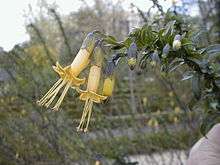Vestia foetida
| Vestia foetida | |
|---|---|
 | |
| Scientific classification | |
| Kingdom: | Plantae |
| (unranked): | Angiosperms |
| (unranked): | Eudicots |
| (unranked): | Asterids |
| Order: | Solanales |
| Family: | Solanaceae |
| Genus: | Vestia Willd. |
| Species: | V. foetida |
| Binomial name | |
| Vestia foetida Hoffmanns.[1] | |
Vestia is a monotypic genus[2] of flowering plants in the family Solanaceae containing the single species Vestia foetida (syn. V. lycioides). Its common name is Chilean box thorn. It is native to Chile. Growing to 2 m (7 ft) tall by 1.5 m (5 ft) broad, it is an evergreen shrub with glossy green leaves. In spring and summer it bears tubular yellow flowers to 3 cm (1 in) long with prominent stamens.[3]
The specific epithet foetida refers to the unpleasant smell of this plant.[4]
Although frost-hardy, the plant requires some protection from winter winds.[3] It has gained the Royal Horticultural Society's Award of Garden Merit.[5]
References
- ↑ "International Plant Names Index (IPNI) - Vestia foetida". Retrieved 8 May 2013.
- ↑ Las Penas, M. L., et al. (2006). Karyotypes of some species of Cestrum, Sessea, and Vestia (tribe Cestreae, Solanaceae). Caryologia 59(2) 131-37.
- 1 2 RHS A-Z Encyclopedia of Garden Plants. United Kingdom: Dorling Kindersley. 2008. p. 1136. ISBN 1405332964.
- ↑ Harrison, Lorraine (2012). RHS Latin for Gardeners. United Kingdom: Mitchell Beazley. p. 224. ISBN 9781845337315.
- ↑ Vestia foetida. Royal Horticultural Society.
This article is issued from Wikipedia - version of the 12/12/2014. The text is available under the Creative Commons Attribution/Share Alike but additional terms may apply for the media files.